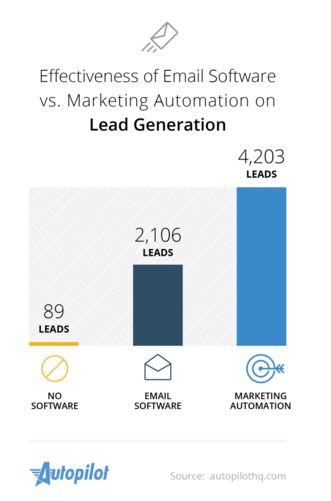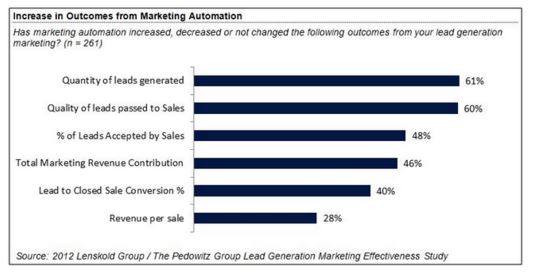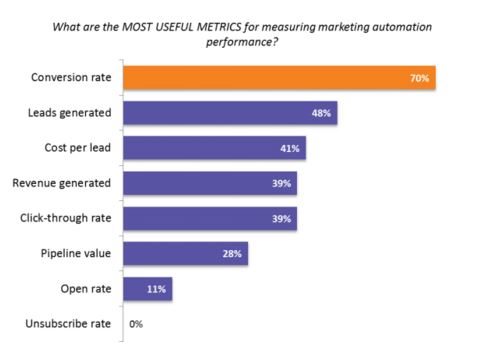75 Marketing Automation Stats
Marketing automation is a big topic these days. Using it can make your marketing processes more effective and efficient, and talking about it can definitely make you seem smarter. So to give you a be-all-end-all list about a super relevant topic, I’ve pulled together the industry’s most trusted stats (with sources) that you can bookmark and refer back to whenever you need them.
You’ll find key data on adoption, usage, challenges and benefits. And to sweeten the deal, we’ve provided a free downloadable study on The Rise of Niche Marketing Automation Platforms that focuses on solutions designed for agencies and media companies, exclusively.
Marketing Automation Adoption
- CMOs at top-performing companies indicate their most compelling reason for implementing marketing automation is to increase revenue ( 79%) and to get higher quality leads (76%). (Source: Gleanster, Q3 Marketing Automation Benchmark” , 2013)
- 64% of CMOs have no formal process to manage their email marketing. (Source: Fathom, “28 Marketing Stats that Matter”, 2013)
- Only about 4% of US businesses with 20 or more employees are users of marketing automation software. (Source: VentureBeat, “Buyers and Users Marketing Automation Survey: Results, Analysis and Key Findings”, 2014)
- More than 60% of marketers use mass email blasts to stay in touch with customers, however only 13% are using automation software. (Source: Autopilot, “Marketing Automation Performance Report”, 2015)
- Only 22% of companies are using marketing automation software today, trailing far behind more mainstream channels like social media or the corporate website. (Source: Salesforce, “State of Marketing”, 2015)
- Best-in-class companies are 67% more likely to use a marketing automation platform. (Source: Aberdeen Group, “State of Marketing Automation 2014: Processes that Produce”, 2014)
- 79% of top-performing companies have been using marketing automation for more than 2 years. (Source: Gleanster, “Q3 Marketing Automation Benchmark”, 2013)
- Marketing automation will be amongst the most piloted marketing technologies of 2015. (Source: Salesforce, “State of Marketing”, 2015)
- 56% of companies use an email marketing provider. This is a significant as companies that use email marketing are 75% or more likely to be purchasers of marketing automation software over the next year. (Source: VentureBeat, “Buyers and Users Marketing Automation Survey: Results, Analysis and Key Findings”, 2014)
- 63% of companies successful in marketing automation plan to increase their marketing automation budget. The companies with successful automation programs will invest in further success in the coming year. (Marketo & Ascend2 “Marketing Automation Strategies for Sustaining Success”, 2015)
- 58% of top-performing companies (defined as those where marketing contributes more than half of the sales pipeline), have adopted marketing automation. (Soure: Forrester Research, “Gauging Your Progress and Success”, Dec 2013)
- Among CMOs, the most important criteria for a marketing automation system are ease-of-use (92%) and the ability to tie marketing performance to sales (72%). (Source: Gleanster, “Q3 2013 Gleanster Marketing Automation Benchmark,” 2013)
- Among B2B marketing managers, the most important criteria for a marketing automation system are (1) price, (2) product integration (e.g., CRM, social, web, mobile), and (3) ease of use. (Source: Pepper Global, “Marketing Automation Trends Report 2014”, 2013)
- The industries with the highest adoption rates are:
- Software & Internet
- Telecommuncations
- Computer & Electronics
- Health & Pharmaceuticals
- Business Services
(Source: Mintigo, “State of the Marketing Technology Industry”, 2014)
Marketing Automation Usage
- 20% of agencies make extensive use of marketing automation. Only 30% of agencies aren’t using it to distribute content, prove inbound marketing ROI, and improve inbound effectiveness with personalized targeting. (Source: SharpSpring & Ascend2 “Inbound marketing: Benchmarks from the Agency Perspective”, 2014)
- Nearly 70% of businesses are using a marketing automation platform (MAP) or currently implementing one. (Source: Aberdeen Group “State of Marketing Automation 2014: Processes that Produce”, 2014)
- 54% of CMOs have either begun or completed their implementation of marketing automation software. (Source: MarketingSherpa, “CMO Perspective on B2B Marketing Automation”, 2011)
- 38% of marketing automation users were actively considering switching marketing automation systems in the coming year. (Source: VentureBeat, “Buyers and Users Marketing Automation Survey: Results, Analysis and Key Findings”, 2014)
- 85% of B2B marketers using a marketing automation platform feel that they’re not using it to its full potential. (Source: SiriusDecisions, “Eight is NOT Enough: Increasing Adoption of Marketing Automation Platforms,” 2014)
- Only 26% of B2B marketing automation users have fully adopted their system. (Source David Raab, “Customer Experience Matrix”, 2013)
- Nearly one in four respondents found marketing automation systems too complex to be used effectively. (Source: Autopilot, “Marketing Automation Performance Report”, 2015)
- 44% of marketers are not fully satisfied with their automation systems, the top 3 reasons being that the software takes too long to implement, is difficult to learn and is too expensive. (Source: Autopilot, “Marketing Automation Performance Report”, 2015)
- 76% of CMOs list high-end lead generation as their biggest marketing automation challenge. (Source: Fathom, “28 Marketing Stats that Matter”, 2013)
- The most commonly used marketing automation features are email marketing (89%), lead nurturing (84%), integrations with other software (CRM, mobile, social media, etc) for centralising customer intelligence (80%) and cross-channel campaign management (82%). (Source: Regalix, “
 State of Marketing Automation”, 2014)
State of Marketing Automation”, 2014)
- While companies using blast email software still generate more leads than those who use nothing at all, marketers using automation software generate 2X the number of leads than those using blast email software and are perceived by their peers to be 2X as effective at communicating. (Source: Autopilot, “Marketing Automation Performance Report”, 2015)
- Companies that use marketing automation are 3x more likely than companies without automation to track and attribute their content-marketing efforts to multiple touchpoints (36% to 11%). (Source: The Lenskold Group, “Lead Generation and Marketing Effectiveness Survey”, 2013)
- Companies using marketing automation see 53% higher conversion rates from initial response-to-MQL and a revenue growth rate that is 3.1% higher than non-users. (Source: Aberdeen Group, “Marketing Lead Management Report”, 2012)
- 28% of marketing teams using automation reported an increase in the average deal size from a marketing qualified lead that was passed to sales; the credit goes to the stronger relationship resulting from nurturing and educating buyers. (Source: Lenskold, “Lead Generation Marketing Effectiveness Study”, 2012)

(Source: Lenskold, “Lead Generation Marketing Effectiveness Study”, 2012)
Marketing Automation Challenges

- Main barriers to adoption of Marketing automation are: 1) No Need 2) No budget 3) No management approval. (Source: ResearchCorp “Demand Generation Adoption Survey”, 2014)
- 50% of companies indicate technology integration complexity is the most challenging obstacle for success. The result is that only 25% of companies have extensively integrated their disparate marketing technology systems. Nearly as many (22%) have not integrated their marketing technologies at all. (Source: Ascend2 “Marketing Technology Strategy”, 2015)

- The biggest problem areas when using Marketing Automation for less than 2 years are: Pipeline Reporting, Measuring marketing campaign effectiveness and increasing sales effectiveness. (Source: Heinz Marketing and ontarget “Marketing Automation Effectiveness and Performance Survey”, 2014)
- The most challenging obstacles to success are lack of quality content (40%), budget constraints (38%) and the lack of an effective marketing automation strategy (38%). (Source: Marketo & Ascend2, “Marketing Automation Strategies for Sustaining Success”, 2015)
- A lack of mature marketing practices/processes is the #1 reason for not implementing a marketing automation platform. Indicated by 45% not currently using a MAP. (Source: Aberdeen Group “State of Marketing Automation 2014: Processes that Produce”, 2014)

- 61% agree that the implementation process of Marketing Automation was difficult. (Source: B2Bmarketing.net and Circle Research, “Benchmarking Report Marketing automation”, 2015)
- 54% of marketers that hadn’t implement Marketing Automation, said it was part of their plan, but they have other elements in need of more immediate attention. 21% said that the cost structures where Prohibitive. (Source: Redeye and TFM&A Insights, “The Marketing Automation Report 2014”, 2014)
- 13% of the marketers said a Lack of technical proficiency in their team was stopping them from adopting Marketing Automation. A lack of understanding of benefits is holding back 12% – Redeye and TFM&A Insights “The Marketing Automation Report 2014” (2014)
- 57% of respondents admit their marketing infrastructure is separated by channel, not well-integrated, or lacking entirely. (Source: Forrester Research & Oracle “Why You Need To Be A Modern Marketer”, 2014)
- Only 14% have standardized, fully integrated cross-channel marketing automation platforms, with 42% of retailers standing out as more advanced than other verticals using this type of solution. (Source: Forrester Research & Oracle “Why You Need To Be A Modern Marketer”, 2014)
- 66% marketers reported allocating less than 10% of their budget to marketing automation. (Source: Regalix, “The State of Marketing Automation”, 2014)
- 54% marketers who have not yet implemented marketing automation cite lack of budgets as a major obstacle preventing implementation. (Source: Regalix, “The State of Marketing Automation”, 2014)
- 38% of marketing automation users were actively considering switching marketing automation systems in the coming year. (Source: VentureBeat, “Buyers and Users Marketing Automation Survey: Results, Analysis and Key Findings”, (2014)
Marketing Automation Benefits
- Marketers that have adopted marketing automation say the main benefits are:
- Taking repetitive tasks out of marketers hands, allowing focus on new/more exciting projects (36%)
- Better targeting of customers and prospects (30%)
- Improving the customer experience (10%)
- Better email marketing (9%)
- Reduction of human error in campaigns (8%),
- Lead management (4%) and multichannel marketing (3%)
(Source: Redeye and TFM&A Insights, “The Marketing Automation Report 2014”, 2014)
- B2B marketers say the #1 benefit of marketing automation as the ability to generate more and better leads. (Source: Pepper Global “Marketing Automation Trends Report 2014”, 2013)
- Marketers say that the biggest benefits of automation are saving time (74%), increased customer engagement (68%), more timely communications (58%) and increased opportunities including up-selling (58%) (Source: Adestra Marketer vs Machine, 2015)
- 80% of marketing automation users saw their number of leads increase, and 77% saw the number of conversions increase. (Source: VentureBeat, “Marketing Automation, how to make the right buying decision”, 2015)
- 27% of those new to the technology report “more relevant messages” as a result, but that increases with time to 74% for the veteran marketing automation users started using MA more than two years ago. (Source: B2Bmarketing.net and Circle Research, “Benchmarking Report Marketing automation”, 2015)
- 67% of B2B marketers say they see at least 10% increase in sales opportunities through lead nurturing, with 15% seeing opportunities increase by 30% or more. (Source: DemandGen “2014 Lead Nurturing Benchmark Study”, 2014)

- The most useful measure of marketing automation performance is conversion rate, say 70% of very successful marketing automation users. (Source: Marketo & Ascend2 “Marketing Automation Strategies for Sustaining Success”, 2015)
- B2B marketers who implement marketing automation increase their sales-pipeline contribution by 10%. (Source: Forrester Research, “The Forrester Wave Lead-To-Revenue Management Platform Vendors”, 2014)
- Marketing automation high performers have an average of 60% higher lead-to-sale conversion rating. These high performers rate cost of customer acquisition (COCA) 1.4x stronger. (Source: PR20/20 “Marketingscore report”, 2014)
- B2B marketers see an average 20% increase in sales opportunities from nurtured leads versus non-nurtured leads after successfully deploying a lead nurturing program. (Source: DemandGen, “Calculating the Real ROI from Lead Nurturing”, 2013)
- Companies that have adopted marketing automation perform well compared to companies that haven’t:
- 45% regularly repurpose content for efficiency, compared with 28% of companies without marketing automation
- 54% capture intelligence for the sales team, compared to 25% without marketing automation
- 49% customize content to the Buyer Journey stages, compared to 21% without marketing automation
- 59% can use intelligent targeting to trigger content, compared to 17% without marketing automation
(Source: The Lenskold Group, “2013 Lead-Generation Marketing Effectiveness Study”, 2013)
- 63% of companies that are outgrowing their competitors use marketing automation. (Source: The Lenskold Group, “2013 Lead-Generation Marketing Effectiveness Study”, 2013)
- B2B marketers who implement marketing automation software increase their sales pipeline contribution by an average of 10%. (Source: Forrester Research, “The Forrester Wave Lead-To-Revenue Management Platform Vendors”, 2014)
- The #1 benefit of marketing automation according to B2B marketers is the ability to generate more and better quality leads. (Source: Pepper Global “Marketing Automation Trends Report 2014”, 2013)
- Nurtured leads produce, on average, a 20% increase in sales opportunities versus non-nurtured leads. (Source: DemandGen, “Calculating the Real ROI from Lead Nurturing”, 2013)
- Marketing automation drives a 14.5% increase in sales productivity and a 12.2% reduction in marketing overhead. (Source: Nucleus Research, “Marketing Drives CRM ROI”, 2012)
- Companies that excel in lead nurturing generate 50% more sales-ready leads at 33% lower cost per lead. (Source: Forrester Research & Oracle “Why You Need To Be A Modern Marketer”, 2014)
- 75% of companies using marketing automation see ROI in just 12 months. (Source: Focus Research, 2013)
- 78% of successful marketers say that marketing automation is most responsible for improving revenue contribution. (Source: The Lenskold Group “2013 Lead Generation Marketing Effectiveness Study”, 2013)
- Businesses that use marketing automation to nurture prospects experience a 451% increase in qualified leads. (Source: The Annuitas Group, 2014)
- 67% of marketing automation-users listed the technology as “very effective/effective. (Source: Salesforce, “State of Marketing”, 2015)
- While companies using blast email software still generate more leads than those who use nothing at all, marketers using automation software generate 2X the number of leads than those using blast email software and are perceived by their peers to be 2X as effective at communicating. (Source: Autopilot, “Marketing Automation Performance Report”, 2015)
- Successful lead nurturing breeds educated, gratified customers who channel their satisfaction into their purchase sizes, making 47% larger purchases than non-nurtured leads. (Source: Kapost, “8 Benefits of Integrating Your CRM with Marketing Automation”, 2014)
- 63% of companies that are outgrowing their competitors use automation in their email marketing. (Source: The Lenskold Group “2013 Lead Generation Marketing Effectiveness Study”, 2013)
- 87% of top-performing marketers say targeting campaigns to audience segments and individual consumers is the largest value driver, with 78% listing segmentation as the #1 marketing-automation capability they can’t live without. (Source: Gleanster, “5 Marketing Automation Capabilities Top Performers Can’t Live Without”, 2012)
- Marketers who have adopted an automation system suggest that the biggest benefits are:
- Taking repetitive tasks out of marketers hands, so they can work on other projects (36%)
- Better targeting their prospects and existing customers (30%)
- Improving customer experience (10%)
- Better email marketing (9%)
- Reduction of human error (8%)
- Lead management (4%)
- Multichannel marketing (3%)
(Source: The Lenskold Group “2013 Lead Generation Marketing Effectiveness Study”, 2013)
Marketing Automation Personalization & Nurturing
- 86% of senior-level marketers say that it’s absolutely critical or very important to create a cohesive customer journey. (Source: Salesforce, “State of Marketing”, 2015)
- 86% of shoppers who have experienced personalization believe it influences what they purchase to some extent. (Source: Digital Capital Advisors, “Marketing Technology Sector Update: Marketing Automation”, 2015)
- Personalized emails improve click-through rates by 14%, and conversion rates by 10%. (Source: Aberdeen Group, “B2B Social Media Marketing: Are We There Yet?”, 2012)
- Companies that nurture their leads get 45% more lead generation ROI than companies that do not. (Source: MarketingSherpa, “B2B Marketing Benchmark Report”, 2012)
- Nurtured leads make purchases that are 47% larger, on average, than non-nurtured leads. (Source: Annuitas 2011)
73. 74% of top-performing companies use automated lead nurturing. Among average- or less-performing companies that use marketing automation, 2/3 fail to leverage the platform’s lead nurturing capabilities. (Source: Gleanster, “Nurture Marketing for the Overwhelmed Marketer”, 2013)
- Roughly 15-20% of non sales-ready leads eventually purchased after lead nurturing. (Source: Gleanster, “Measuring the Impact of Lead Nurturing on the Sales Pipeline”, 2010)
- Marketers who segment their lists and employ quality targeting can improve conversion by 355% and increase revenues by 781%. (Source: Jupiter Research (2011)
[adrotate banner="134"]

